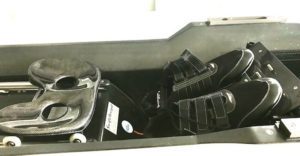Let us ask you this: "Why should you rig your rowing equipment?" Can you list a few reasons? How about three? Five? (There are even more than that!)
REASON #1: COMFORT
Ever take a long drive while sitting in a car seat that just didn't fit very well? How about writing an essay paper with a pen that is too big? Or talking on a phone where the cord is way too short? (Remember those days when phones had cords?)
If you've ever endured any of these things, or have done anything else with a piece of equipment or with a tool that didn't fit right, then you have a pretty darn good idea of what it's like to row with equipment that is not adjusted correctly.
- It can be terribly uncomfortable.
- And when it's uncomfortable, it's inefficient.
- And when it's inefficient, it's discouraging.
- And when rowing is discouraging, well . . . it misses the mark.
When you rig, the comfort of the rower has to be of prime concern. Okay, we know that rowing is a tough sport and we like that image, and Martha Stewart has no real place in our sport. However, when people row, especially long distances, the equipment has got to be as comfortable as possible for the rowers because if it's not, then all but only the truly masochistic rowers will survive.
Simply put, rigging can help rowing be more comfortable.
REASON #2: SPEED
For rowing coaches, speed is our Holy Grail. It is that elusive item we seem to spend hours, days, weeks, months, and years chasing.
Rigging is critical to generating maximum boat hull speed. If it is speed you're after, then you must rig; without it, you may find max hull speed to be very elusive.
REASON #3: SAFETY
Rowing is about as equipment-intensive a sport as there is. That means that a rower's body is going to be in contact with the equipment.
To be specific, there are four places where the body touches the equipment:
The butt, the back of the calves, the hands, and the feet. These areas make up only about ten percent of a body's surface, but boy, that ten percent is important. I call these places the "hot spots," and if there is a problem in one of these areas, it can really mess up your rowing.
For example, little nasties like blisters have been known to stop armies dead in their tracks, and they certainly can make your rowing uncomfortable and inefficient. So can a smashed knuckle. Or even worse, an incredible case of screaming "boat butt" or janni-bum.
In Mike Davenport's clinics he often relates the story of seeing eight stud-type rowers get off the water after a spin in one of the first boats in the country with adjustable slides. The boat was new and no one was quite sure how to adjust the slides –in this case, they were adjusted about five inches too far toward the stern. With each stroke, the end of the slides jabbed into their calves, and the end product was eight bleeding, limping, and grumbling rowers.
Correct rigging won't totally eliminate these types of injuries, but it sure can help reduce them.
REASON #4: SMART MONEY
Another benefit of rigging is one of which you may not have thought: helping you to make a wise purchase of equipment.
Knowing exactly what you need when you buy something, whether new or old, is critical to a good purchase. And rigging can help you know what you need to buy.
A few of the base rigging measurements that may come into play here would be:
- Boat size
- Specific rigger adjustment (e.g., height, pitch, spread)
- Boat weight
- Shoe size
- Oar length and pitch
Today, most rowing equipment comes with many options. The days of "making the man fit the boat," as George Pocock used to say, are long gone. Now the boat, and most other equipment, is made to fit the person rowing it, which means there are plenty of choices. When you start looking at the options available you may get overwhelmed.
Where do you put the coxswain: in the bow or in the stern? What pitch do you want on the oars? What height range do you want on your riggers? What shoe sizes? What color?
The list goes on and on.
Being versed in rigging when you are purchasing equipment is critical to spending your money (or someone else's) wisely.
REASON #5: HELPING THE EQUIPMENT LAST LONGER
Your rowing equipment represents a big chunk of money. Like most folks, you want to get as much from that investment as possible. Rowing stuff is designed to survive the hardships of daily use; however, even the toughest equipment isn't ready to withstand the hardest challenges of its life, like transits, storage, novice rowers, and abuse from incorrect rigging numbers.
How does rigging make a difference?
It's similar to the air pressure in your tyres. When properly inflated, tyres will last a lot longer. When over- or under-inflated, the tyres wear incredibly fast. And the same goes for rowing equipment. For instance, significantly incorrect pitch settings on a rigger can cause premature wear of an oarlock or of a collar.
Proper rigging can make the difference in rowing equipment lasting two years or twenty years, and who can afford to replace oars, riggers, and shells every two years?
Lesson 4, the next lesson, is about Who Should Rig and we'll get into the nitty-gritty of rigging.







